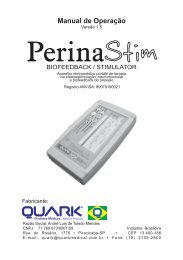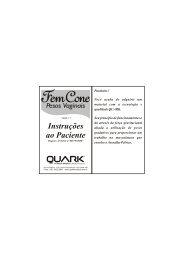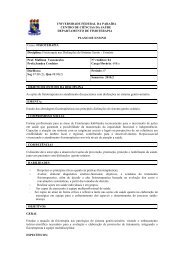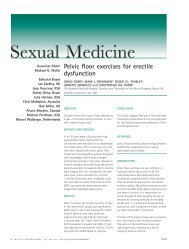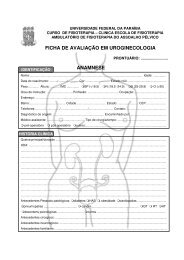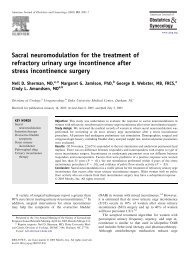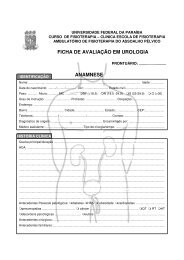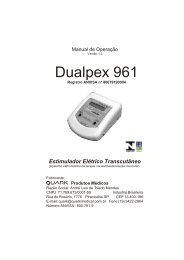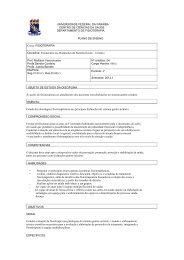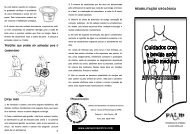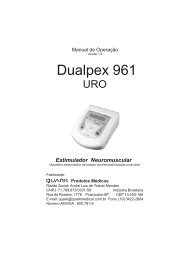vacuum constriction devices for erectile dysfunction
vacuum constriction devices for erectile dysfunction
vacuum constriction devices for erectile dysfunction
Create successful ePaper yourself
Turn your PDF publications into a flip-book with our unique Google optimized e-Paper software.
VACUUM CONSTRICTION DEVICES FOR ERECTILE<br />
DYSFUNCTION: A LONG-TERM, PROSPECTIVE STUDY OF<br />
PATIENTS WITH MILD, MODERATE, AND<br />
SEVERE DYSFUNCTION<br />
TIMOTHY C. DUTTA AND JEAN FRANCOIS EID<br />
ABSTRACT<br />
Objectives. To evaluate, using a long-term, prospective study, the satisfaction rate, attrition rate, and<br />
follow-up treatment of well-trained patients using an external <strong>vacuum</strong> erection device, the Osbon ErecAid<br />
System, in the treatment of mild, moderate, and severe organic <strong>erectile</strong> <strong>dysfunction</strong>.<br />
Methods. One hundred twenty-nine patients were assessed to determine the severity and cause of their<br />
<strong>erectile</strong> <strong>dysfunction</strong>. Patients with organic <strong>erectile</strong> <strong>dysfunction</strong> who were interested in the Osbon ErecAid<br />
received the device after thorough training. Patients received a follow-up questionnaire regarding satisfaction,<br />
months of use, reasons <strong>for</strong> discontinuing, and further treatment.<br />
Results. Our attrition rate was 65% overall and was lowest among patients with moderate <strong>erectile</strong> <strong>dysfunction</strong><br />
(55%). All patients with mild <strong>dysfunction</strong> discontinued use, and a large number (70%) of patients with<br />
complete <strong>dysfunction</strong> also discontinued use. Of the patients who discontinued, most stopped treatment<br />
early (median 1 month, mean 4 months) and 63% did not seek further treatment. Thirty-five percent of<br />
patients were satisfied with the device and have continued to use it long term (mean 37 months).<br />
Conclusions. Our study showed a lower success rate than previous reports. Patients who were satisfied with<br />
the Osbon ErecAid continued to use it <strong>for</strong> long periods. Patients who were not satisfied dropped out very<br />
quickly, and many did not seek further treatment. Patients with moderate <strong>erectile</strong> <strong>dysfunction</strong> had a higher<br />
rate of success than patients with mild or severe <strong>erectile</strong> <strong>dysfunction</strong>. UROLOGY 54: 891–893, 1999.<br />
© 1999, Elsevier Science Inc.<br />
Erection-inducing <strong>vacuum</strong> constricting <strong>devices</strong><br />
(VCDs) were described as early as 1917, but<br />
did not become widely used until the 1970s. 1 By<br />
promoting penile blood engorgement with a suction<br />
chamber and maintaining tumescence with a<br />
constricting band, VCDs assist in achieving an<br />
erection. The potential strengths of this therapy are<br />
its nonmedical, noninvasive nature and its costeffectiveness.<br />
The potential weaknesses include<br />
the learning required to use it, complaints of lack<br />
of full rigidity of the penis and lack of rigidity proximal<br />
to the constricting band, and a sense of lack of<br />
spontaneity because of the mechanical nature of<br />
From the Department of Urology, New York Hospital-Cornell<br />
Medical Center, New York, New York<br />
Reprint requests: Jean Francois Eid, M.D., Department of Urology,<br />
New York Hospital-Cornell Medical Center, 525 East 68th<br />
Street, Box 29, New York, NY 10021<br />
Submitted: October 13, 1998, accepted (with revisions): May<br />
20, 1999<br />
ADULT UROLOGY<br />
the device. Numerous published reports exist that<br />
describe this treatment as very effective. 2–7 As<br />
newer treatments <strong>for</strong> <strong>erectile</strong> <strong>dysfunction</strong> emerge,<br />
it is important to better determine <strong>for</strong> which patients<br />
VCDs are appropriate, what outcomes to expect<br />
from their use, and, <strong>for</strong> patients who fail, what<br />
alternatives to choose. We conducted a long-term,<br />
prospective study of patients who were well<br />
trained in the use of the Osbon ErecAid VCD (Osbon<br />
Medical Systems, Augusta, Ga). By stratifying<br />
patients by severity of <strong>erectile</strong> <strong>dysfunction</strong>, it was<br />
our intent to display any differences in success<br />
rates among these groups. Furthermore, with excellent<br />
and consistent training of all patients by an<br />
Osbon representative, we believe that the patients<br />
in our study had the best opportunity <strong>for</strong> success<br />
with the VCD. With long-term follow-up, we proposed<br />
to determine when patients would stop using<br />
the VCD and <strong>for</strong> how long those who were<br />
satisfied with it would continue its use.<br />
© 1999, ELSEVIER SCIENCE INC. 0090-4295/99/$20.00<br />
ALL RIGHTS RESERVED PII S0090-4295(99)00264-2 891
MATERIAL AND METHODS<br />
PATIENT EVALUATION<br />
Between 1990 and 1996, 146 patients were enrolled in our<br />
Osbon study. These patients all presented to our clinic with a<br />
complaint of <strong>erectile</strong> <strong>dysfunction</strong>. All patients completed a<br />
detailed sexual function questionnaire at their initial office<br />
visit. From this survey, the duration and severity of the <strong>erectile</strong><br />
<strong>dysfunction</strong> were determined.<br />
The <strong>erectile</strong> <strong>dysfunction</strong> of patients whose penis had atrophy<br />
with degenerative changes of the penile tissue and whose<br />
penis was completely limp or became full but without hardness<br />
was classified as complete. The <strong>erectile</strong> <strong>dysfunction</strong> of<br />
patients who achieved sufficient hardness <strong>for</strong> intromission but<br />
were unable to maintain their erection was classified as moderate.<br />
The <strong>erectile</strong> <strong>dysfunction</strong> of those patients who could<br />
penetrate and achieve orgasm was classified as mild.<br />
Each patient was seen and evaluated by one of us (J.F.E.),<br />
who took a detailed medical and sexual history. A complete<br />
physical examination was conducted, as were studies of serum<br />
testosterone and duplex Doppler ultrasound of the penile arteries<br />
combined with intracavernous administration of prostaglandin<br />
E 1. In this manner, all patients were diagnosed with<br />
vascular, cavernosal, neurogenic, or hormonal <strong>erectile</strong> <strong>dysfunction</strong>.<br />
Only patients with these organic diagnoses were included<br />
in the study.<br />
INSTRUCTION<br />
Patients with a diagnosis of organic <strong>erectile</strong> <strong>dysfunction</strong><br />
were presented, in a nonbiased manner, with choices of no<br />
treatment, VCD, injection, or implantation. All patients included<br />
in the study chose the VCD as the first line treatment.<br />
The Osbon VCD was the only device prescribed to limit variables<br />
and because tutoring by an Osbon representative was<br />
available. All patients received verbal instruction from an Osbon<br />
ErecAid representative on the use of the VCD, viewed a<br />
videotape, and received an individual demonstration. If the<br />
patient achieved a satisfactory erection with the sales representative<br />
in an office setting, the patient received a prescription<br />
<strong>for</strong> the Osbon ErecAid System. Patients were then followed<br />
up by one of us (J.F.E.) and obtained advice or<br />
alternative treatments as necessary.<br />
FOLLOW-UP<br />
In late 1996, patients received a follow-up questionnaire by<br />
mail. Those who did not respond or did not complete the<br />
questionnaire entirely were followed up by telephone. Patients<br />
who could not be reached were considered to have<br />
dropped out of the study.<br />
RESULTS<br />
Of the 146 patients originally enrolled in the<br />
study, 129 completed the patient questionnaire<br />
and were included the analysis. The mean time of<br />
follow-up was 37 months after receiving the Osbon<br />
prescription. All but 11 patients included in the<br />
study had filled their prescription more than 12<br />
months be<strong>for</strong>e completing the follow-up questionnaire.<br />
At the conclusion of the study, 84 patients<br />
(65%) were no longer using the device (inactive),<br />
and 45 patients (35%) were still using it (active).<br />
Patient age and diagnosis were comparable between<br />
the two groups. The mean age of active patients<br />
was 66 years (range 52 to 78), compared<br />
with 64 years (range 39 to 80) <strong>for</strong> inactive users.<br />
FIGURE 1. Months of use from time of purchase until<br />
discontinuing.<br />
Diagnoses were very similar between the two<br />
groups; the most common etiology was vascular,<br />
followed by cavernosal, neuronal, and hormonal.<br />
Nine of the patients (7%) had mild <strong>erectile</strong> <strong>dysfunction</strong>,<br />
54 (42%) had moderate <strong>erectile</strong> <strong>dysfunction</strong>,<br />
and 66 (51%) had complete <strong>erectile</strong> <strong>dysfunction</strong>,<br />
as defined above. All 9 patients with mild<br />
<strong>erectile</strong> <strong>dysfunction</strong> discontinued use of the VCD.<br />
Patients with complete <strong>erectile</strong> <strong>dysfunction</strong> also<br />
quit at higher rates (70% quit and 30% continued).<br />
Patients with moderate <strong>erectile</strong> <strong>dysfunction</strong> were<br />
the most likely to continue using the device (55%<br />
quit and 45% continued). Fisher’s exact test <strong>for</strong> use<br />
status as a function of severity indicated that the<br />
percentage of patients who stopped was significantly<br />
different across the severity levels (P <br />
0.01).<br />
Among inactive patients, the average number of<br />
months be<strong>for</strong>e quitting was 4 months (median 1,<br />
range 1 to 36) (Fig. 1). The three most common<br />
reasons <strong>for</strong> stopping use were as follows: 48% (n <br />
57) considered it ineffective, 20% (n 17) too<br />
painful, and 24% (n 20) too cumbersome (Table<br />
I). Additional reasons <strong>for</strong> drop out were as follows:<br />
5 considered the erection to be artificial, which led<br />
to a loss of desire, 2 reported loss of a partner, and<br />
6 reported that their ability to obtain a natural erection<br />
had been restored. Follow-up treatments <strong>for</strong><br />
the 84 patients who dropped out were as follows:<br />
31% (n 26) received intracavernosal therapy, 6%<br />
(n 5) received a prosthesis, and 63% (n 53)<br />
chose to receive no further treatment (Table I).<br />
COMMENT<br />
Previous studies of VCDs have had varying satisfaction<br />
rates. Some studies have shown high satisfaction<br />
rates, 3,6–9 but other studies have shown<br />
lower satisfaction rates. 1,10 Some researchers have<br />
892 UROLOGY 54 (5), 1999
TABLE I. Reason <strong>for</strong> discontinuation and new<br />
treatment among inactive patients<br />
n (%)<br />
Reason*<br />
Ineffective 48 (57)<br />
Cumbersome 20 (24)<br />
Too painful 17 (20)<br />
Lack of interest 5 (6.0)<br />
Loss of partner 2 (2.4)<br />
Problem resolved<br />
New treatment<br />
6 (7.1)<br />
No new treatment 53 (63)<br />
Injections 26 (31)<br />
Surgery 5 (6.0)<br />
* Patients were allowed to give two reasons.<br />
argued that success rates are highly determined by<br />
the degree of training. 11 We believe that we studied<br />
the most motivated and best trained cohort of patients<br />
clinically possible. All patients chose the<br />
VCD as the first line therapy and received training<br />
by watching a videotape and having an individual<br />
demonstration with an Osbon representative. Despite<br />
this, our overall failure rate was 65%. Most of<br />
these patients quit early; the median time of drop<br />
out was only 1 month (Fig. 1). These patients most<br />
commonly quit because the device was found to be<br />
ineffective, cumbersome, or painful.<br />
The severity of <strong>erectile</strong> <strong>dysfunction</strong> was a significant<br />
factor in drop-out rates. Patients with moderate<br />
<strong>erectile</strong> <strong>dysfunction</strong> were the most successful.<br />
All patients in our study with mild <strong>erectile</strong><br />
<strong>dysfunction</strong> discontinued use of the VCD. Patients<br />
with complete <strong>erectile</strong> <strong>dysfunction</strong> also had low<br />
success rates. Thus, the VCD was most useful to<br />
patients with moderate <strong>erectile</strong> <strong>dysfunction</strong> (P <br />
0.01).<br />
Sixty-three percent of patients who were unsuccessful<br />
with the VCD sought no further treatment.<br />
In another study by our group, of patients receiving<br />
intracavernosal injections, only 28% of patients<br />
who discontinued injections did not seek further<br />
treatment. 12 In the intracavernosal injection study,<br />
52% of those patients who discontinued injections<br />
opted <strong>for</strong> a prosthesis; only 6% in our VCD study<br />
did. It appears that there may be different motivations<br />
<strong>for</strong> patients seeking these different treatments.<br />
The appeal of the VCD is largely that it is<br />
noninvasive. Patients willing to give themselves injections<br />
may be more willing to try other, more<br />
invasive treatments, and patients who choose the<br />
VCD may be less willing to try more invasive therapies.<br />
This underscores the noninvasive strength<br />
of the VCD.<br />
Of the active patients in our study, these patients<br />
had long-term success with the VCD. The average<br />
duration of use <strong>for</strong> these patients was 37 months<br />
(maximum 84). For these patients, the treatment<br />
successfully provided a cost-effective, noninvasive,<br />
nonmedical therapy. This clearly shows the importance<br />
of the VCD as an option in the treatment of<br />
organic <strong>erectile</strong> <strong>dysfunction</strong>. Again, the success<br />
rates were highest <strong>for</strong> patients with moderate <strong>erectile</strong><br />
<strong>dysfunction</strong>. Moderate <strong>erectile</strong> <strong>dysfunction</strong><br />
was defined as achieving sufficient hardness <strong>for</strong><br />
intromission but being unable to maintain the<br />
erection. Nearly half of these patients were satisfied<br />
with the VCD.<br />
CONCLUSIONS<br />
The Osbon ErecAid provided successful longterm<br />
treatment in 35% of patients overall. Our<br />
study was the first report to stratify patients as having<br />
mild, moderate, or severe <strong>erectile</strong> <strong>dysfunction</strong>.<br />
Patients with moderate <strong>dysfunction</strong> had the highest<br />
rates of success, and all patients with mild <strong>dysfunction</strong><br />
discontinued use of the VCD. Many patients<br />
who were unsuccessful with the VCD did not<br />
seek alternative treatments. The VCD remains a<br />
viable noninvasive treatment <strong>for</strong> <strong>erectile</strong> <strong>dysfunction</strong>,<br />
particularly <strong>for</strong> patients with moderate <strong>dysfunction</strong>.<br />
REFERENCES<br />
1. Gilbert HW, and Gingell JC: Vacuum <strong>constriction</strong> <strong>devices</strong>:<br />
second-line conservative treatment <strong>for</strong> impotence. Br J<br />
Urol 70: 81–83, 1992.<br />
2. Nadig PW, Ware JC, and Blumoff R: Noninvasive device<br />
to produce and maintain an erection-like state. Urology<br />
27: 126–131,1986.<br />
3. Witherington R: Vacuum <strong>constriction</strong> device <strong>for</strong> management<br />
of <strong>erectile</strong> impotence. J Urol 141: 320–322, 1989.<br />
4. Turner LA, Althof SE, Levine SB, et al: Treating <strong>erectile</strong><br />
<strong>dysfunction</strong> with external <strong>vacuum</strong> <strong>devices</strong>: impact upon sexual,<br />
psychological, and marital functioning. J Urol 144: 79–<br />
82, 1990.<br />
5. Wiles PG: Successful non-invasive management of<br />
<strong>erectile</strong> impotence in diabetic men. BMJ 296: 161–162, 1988.<br />
6. Baltaci S, Aydos K, Kosar A, et al: Treating <strong>erectile</strong> <strong>dysfunction</strong><br />
with a <strong>vacuum</strong> tumescence device: a retrospective<br />
analysis of acceptance and satisfaction. Br J Urol 76: 757–760,<br />
1995.<br />
7. Sidi AA, Becher EF, Zhang G, et al: Patient acceptance<br />
of and satisfaction with an external negative pressure device<br />
<strong>for</strong> impotence. J Urol 144: 1154–1156, 1990.<br />
8. Bodansky HJ: Treatment of male <strong>erectile</strong> <strong>dysfunction</strong><br />
using the active <strong>vacuum</strong> assist device. Diabet Med 11: 410–<br />
412, 1994.<br />
9. Cookson MS, and Nadig PW: Long-term results with<br />
<strong>vacuum</strong> <strong>constriction</strong> <strong>devices</strong>. J Urol 149: 290–294, 1993.<br />
10. Meinhardt W, Lycklama A, Nijeholt AAB, et al: The<br />
negative pressure device <strong>for</strong> <strong>erectile</strong> disorders: when does it<br />
fail? J Urol 149: 1285–1287, 1993.<br />
11. Lewis RW, and Witherington R: External <strong>vacuum</strong> therapy<br />
<strong>for</strong> <strong>erectile</strong> <strong>dysfunction</strong>: use and results. World J Urol 15:<br />
78–82, 1997.<br />
12. Gupta R, Kirschen J, Barrow RC, et al: Predictors of<br />
success and risk factors <strong>for</strong> attrition in the use of intracavernous<br />
injection. J Urol 157: 1681–1686, 1997.<br />
UROLOGY 54 (5), 1999 893





